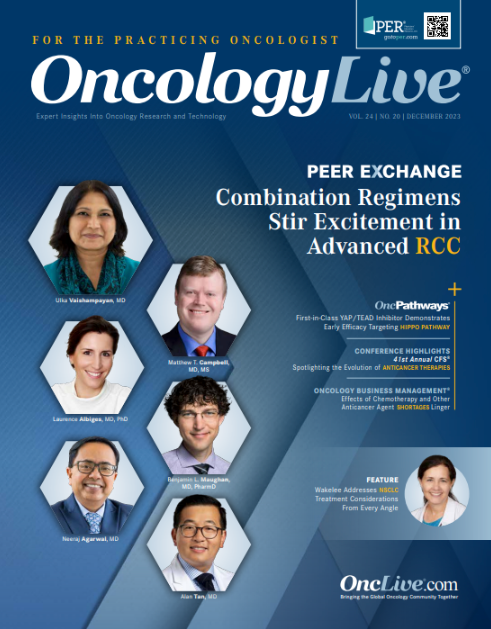When Will We Acknowledge Information Overload in Oncology?
The goal in highlighting this development is to attempt to raise awareness of the critical issue of information overload and the need for multiple involved parties to actively and aggressively search for appropriate, effective, and fiscally rational solutions.
Maurie Markman, MD

It was perhaps inevitable, but nonetheless still striking, when a recently reported commentary discussing a clinically relevant precision cancer medicine topic began by noting a malpractice case lost by an academic medical center due to failure to obtain a specific molecular test that resulted in a serious negative outcome.1 In the opinion of this commentator what is most intriguing here is not the fact the clinical situation occurred, that a patient/family sued the provider’s institution, or that the verdict went against the health care organization, but that the authors of this well-written commentary felt it necessary to highlight their argument regarding the need for such testing in this manner.
Have we come to the point where a threat of legal action against providers is the only remaining mechanism left to somehow “open our eyes,” or, stated more directly, force our collective professional, health system, and regulatory communities to deal with the tsunami of clinically relevant data that increasingly characterizes individual patient decision-making?
The article in question discussed DPYD (dihydropyrimidine dehydrogenase) testing for patients scheduled to receive fluoropyrimidine (eg, 5-fluorouracil)-containing chemotherapy, still today a common scenario despite the multidecade use of this class of antineoplastic agents. As the authors highlight in this well-referenced commentary, anywhere from 1% to 2% to as high as possibly 9% of individuals possess germline polymorphisms that predict for the potential that treatment with this class of agents may result in a serious adverse effect (AE).1
Similarly, solid nonrandomized evidence suggests that the presence of particular molecular profiles should lead a clinician to initiate the delivery of the fluoropyrimidine antineoplastic drug at a lower dose, thereby avoiding or at least substantially reducing the risk of a high-grade toxic event.1,2
The authors of the commentary advocate for the inclusion of DPYD testing within National Comprehensive Cancer Network (NCCN) and American Society of Clinical Oncology (ASCO) guidelines.1 The presumption appears to be that such inclusion will result in substantial encouragement for routine use of currently available commercial testing.1 And although it is unstated, one might anticipate that failure to obtain the test could increase the potential of a legal judgment against a provider (or institution) if an AE occurred and it was subsequently determined that the individual possessed one of the molecular markers associated with the heightened risk.
There will be no debate from this commentator regarding the data supporting routine testing as a component of standard of care (SOC) or the highly relevant safety benefits for the admittedly relatively limited patient population discovered to have a positive germline finding.
So what are the objections to adding routine DPYD testing to the standard order sets for all patients scheduled to receive a fluoropyrimidine-containing regimen? In addition to the costs of such testing for the rather large number of patients receiving this class of pharmaceutical agents, and the possible delay in initiating systemic therapy to obtain the test results that objectively affect a small proportion of individuals, questions remain regarding the overall effect of testing and a degree of uncertainty persists associated with a decision to automatically employ a lower drug dose in the absence of documented excessive toxicity for that individual.1
However, the intent of highlighting this controversy in the current commentary is not to attempt to provide a scholarly or well-reasoned definitive solution, but rather to emphasize just how complex the process of optimizing care delivery has become.
If national group (eg, ASCO, NCCN) guidelines were to label this test as mandated/required SOC or simply declare it to be “strongly recommended,” would this action increase the risk of malpractice claims against health care systems and individual cancer providers?
And this discussion of DPYD testing is truly just the proverbial tip of the iceberg. How long will it be before there are other validated pharmacogenomic tests recommended for noninvestigative use, both specific for antineoplastic agents and the wide variety of noncancer pharmaceuticals taken by patients with cancer? This concern is further heightened by the fact that cancer is a component of aging with risk increasing along with the potential development of other medical conditions for which drug therapy is of clinical value.3
This rapidly evolving data tsunami becomes even more evident when we briefly turn our attention to the increasingly rapid developments in precision cancer therapeutics––those strategies whose biological activities and clinical benefit are defined by unique molecular signatures (targets).
Consider, for example, the current list of FDA-approved tumor-agnostic antineoplastic agents where delivery is defined by the demonstrated presence of specific biomarkers rather than the site of origin of the malignancy. In the extensive American Association for Cancer Research Project Genomics Evidence Neoplasia Information Exchange (GENIE) database (168,423 samples), investigators recently reported that the percentage of molecular abnormalities that would qualify patients for treatment with one of the approved drugs ranged from 1.5% (NTRK fusions) to 15.2% (high tumor mutational burden).4 But even the largest population proportion represents a relatively small minority of all patients (1 of 6 individuals) and the lowest percentage is less than 1 in 50 of those tested.
Should all patients with advanced cancers who have “failed to respond to or progressed on SOC therapy” undergo an evaluation for the potential presence of all molecular abnormalities associated with an FDA-approved antineoplastic agent, even if the likelihood of finding the relevant biomarker is less than 1% to 2%?
Furthermore, it is highly likely that the rapid development of antibody– drug conjugates will substantially accelerate efforts to specifically target unique molecular abnormalities that may characterize small population groups across multiple tumor types (eg, the anti-HER2 agent fam-trastuzumab deruxtecan [Enhertu]).5,6
There is no intent in writing this commentary to suggest that the major justification for ensuring essential clinical decision support for the massive quantity of molecular data that will soon (if it has not already) overwhelm even the most dedicated physician is the risk of a legal claim of malpractice.
Rather, the goal in highlighting this development is to attempt to raise awareness of the critical issue of information overload and the need for multiple involved parties to actively and aggressively search for appropriate, effective, and fiscally rational solutions.
References
- Baker SD, Bates SE, Brooks GA, et al. DPYD testing: time to put patient safety first. J Clin Oncol. 2023;41(15):2701-2704. doi:10.1200/JCO.22.02364
- Hertz DL. Assessment of the clinical utility of pretreatment DPYD testing for patients receiving fluoropyrimidine chemotherapy. J Clin Oncol. 2022;40(33):3882-3892. doi:10.1200/JCO.22.00037
- Hockings JK, Pasternak AL, Erwin AL, Mason NT, Eng C, Hicks JK. Pharmacogenomics: an evolving clinical tool for precision medicine. Cleve Clin J Med. 2020;87(2):91-99. doi:10.3949/ccjm.87a.19073
- Gouda MA, Nelson BE, Buschhorn L, Wahida A, Subbiah V. Tumor-agnostic precision medicine from the AACR GENIE database: clinical implications. Clin Cancer Res. 2023;29(15):2753-2760. doi:10.1158/1078-0432.CCR-23-0090
- Tarantino P, Pestana RC, Corti C, et al. Antibody-drug conjugates: smart chemotherapy delivery across tumor histologies. CA Cancer J Clin. 2022;72(2):165-182. doi:10.3322/caac.21705
- LI BT, Meric-Bernstam F, Bardia A, et al. Efficacy and safety of trastuzumab deruxtecan (T-DXd) in patients (pts) with solid tumors harboring specific HER2-activating mutations (HER2m): primary results from the international phase II DESTINY-PanTumor01 (DPT-01) study. Ann Oncol. 2023;34(suppl 2):S459-S460. doi:10.1016/j.annonc.2023.09.1840




